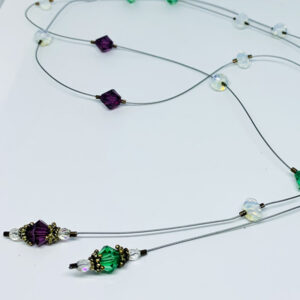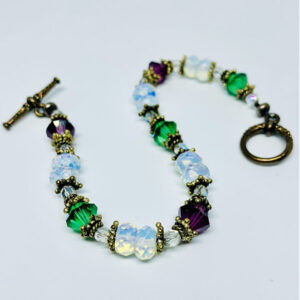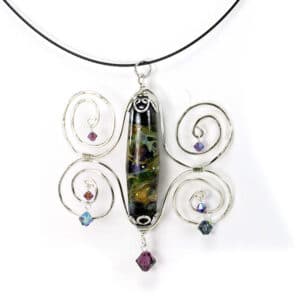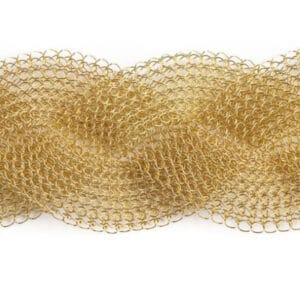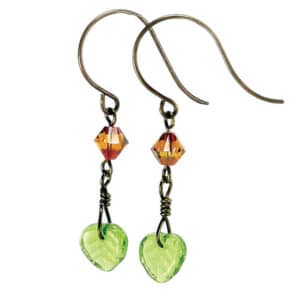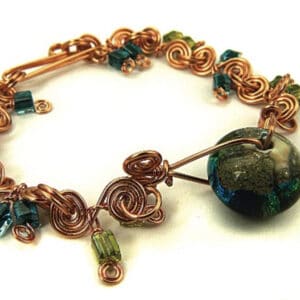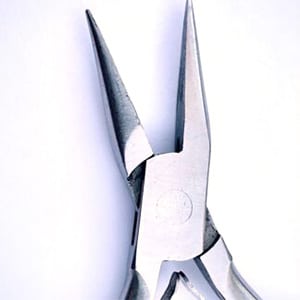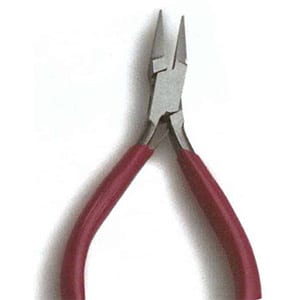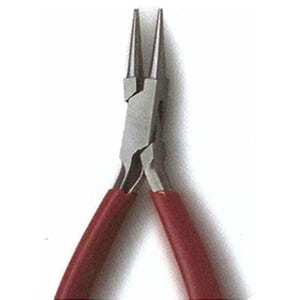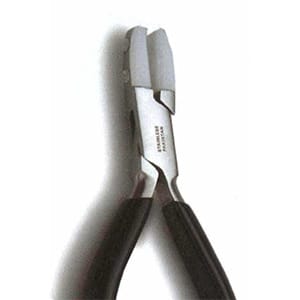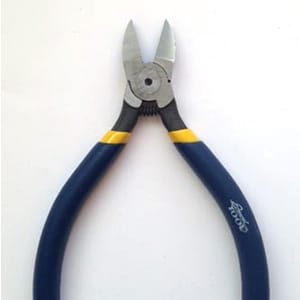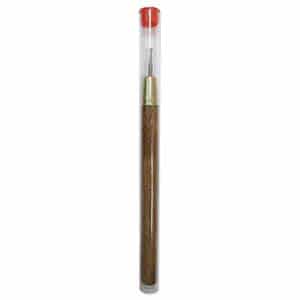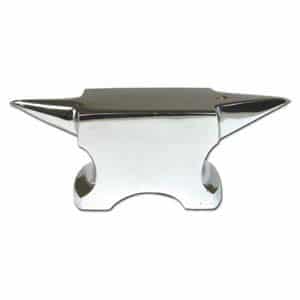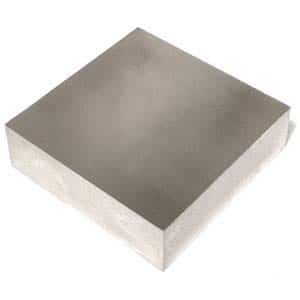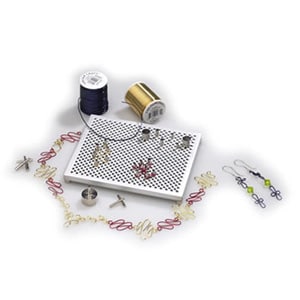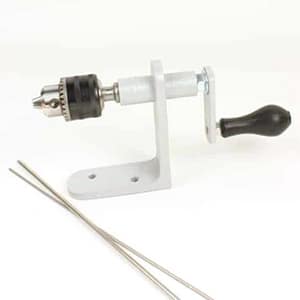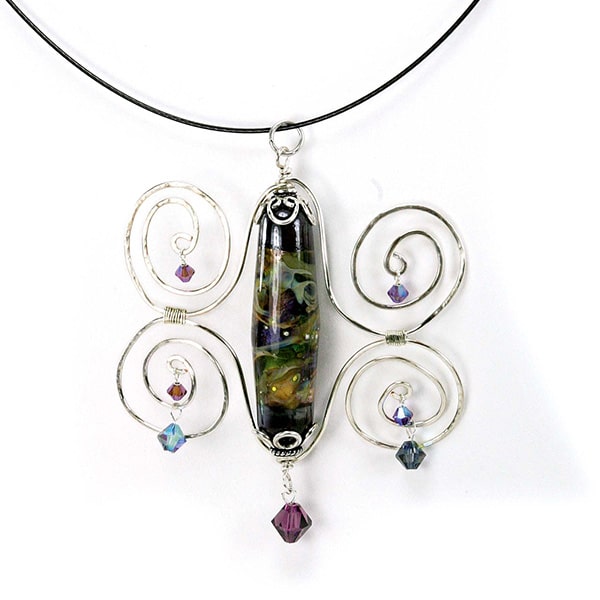
The wonderful world of wire—it isn’t just for florist shops and machinery! A quick Internet image search for “wire designs” or “wire jewelry” will bring up a plethora of gorgeous pieces of jewelry, sculpture, and other works created with this incredibly versatile medium. Intrigued? It’s not always as simple as grabbing some wire and playing (in fact, the subject of wire can get quite technical and scientific), but with our 100 years of experience in the wire industry, our insight might demystify the process and help you in choosing the right wire and tools for your endeavors.
Flexible Beading Wire
In jewelry making, one of the most common types of wire you’ll hear about is flexible stringing wire or beading wire. Although this isn’t the main focus of this article, it’s important to understand the distinction between this and the harder wrapping wires.
Beading wire is used in bead stringing. It consists of numerous strands of very thin stainless steel wire all bound together with a nylon coating. You’ll often see a strand count on the packaging (“7 strands” or “21 strands”); the more strands that are inside the nylon coating, the more supple and strong the wire is. For example, 7-strand beading wire can be stiff and easily kinked, while 21-strand beading wire is much more flexible and drapes beautifully like thread.
This type of wire is not meant to hold its shape when manipulated. Crimp tubes are applied to this wire using a special crimping tool; the crimp tubes help hold beads in place in floating designs and are useful for attaching a clasp or other findings.
Hard Wire (or Wire-Wrapping Wire)
Wire is one of the most essential components in the construction of a piece of jewelry—especially art jewelry. There are many factors to consider when shopping for and working with wire; deciphering which wire to use for what purpose can be a daunting one, but this guide will help you make the best decisions for your piece.
Gauge
The thickness of wire is measured by gauge (sometimes abbreviated as “ga”). Wire is created by pulling a rod of metal over and over again through progressively smaller dies, making the rod thinner with each pass. Ages ago, the gauge number referred to the number of times the wire had been pulled through the die. Today, the gauge is used more as a point of reference rather than an actual wire thickness measurement. (That’s why you’ll sometimes see a millimeter or inch diameter equivalent for each gauge—that’s a true representation of the wire’s thickness.) As a general rule, the larger the gauge number, the thinner the wire. Jewelry/craft wire commonly comes in gauges from 12 (very thick) to 30 (very thin):
- 12 – 18-gauge: Because of their sturdiness, these gauges are great for creating the foundation or base structure (armature) of a piece. They require extra effort to manipulate, but the resulting piece will hold its shape very well under stress. 16- and 18-gauge wire is good for making your own jump rings.
- 20 – 24-gauge: These gauges are a little easier to work, yet they still hold their shape nicely. A simple loop (not wrapped) in 20-gauge wire should hold up very well under stress. 24- and 22-gauge wire is perfect for creating wire-wrapped bead links and components. These gauges are great for making coils and spirals. You can make your own jump rings with 20- and 22-gauge wire, but they won’t be as sturdy as their thicker-gauge counterparts.
- 26 – 30-gauge: These thin-gauge wires are perfect for techniques such as lashing beads to your design, Viking knit, and wire crochet. Wire this thin will hold its shape when manipulated, but the shape will come out under stress. Easily worked, these thin gauges are perfect for wire knitting, crocheting, and weaving.
When you’re shopping for wire, keep in mind that there are multiple standards for measuring gauge (we will cover just two here), which is why the millimeter or inch diameter equivalent is helpful in determining true wire thickness. American Wire Gauge (AWG) is used for non-ferrous metals (copper, brass, silver, aluminum, etc.) and is the most commonly used standard in jewelry and craft wire. Standard Wire Gauge (SWG), also known as Imperial Wire Gauge, is used in Great Britain and Canada. So, for example, if you have a piece of wire with a diameter of .032”, it may be labeled as 20 gauge according to AWG and 21 gauge according to SWG. For basic jewelry applications, it is fine to use the gauge as a general reference point, but—for instance—if you’re working with or creating your own jump rings where the exact wire diameter is important for your design, you will want to pay special attention to the millimeter or inch diameter equivalent.
Materials
From bare copper and colored anodized aluminum to sterling silver and gold-filled, there is a wire to accommodate every style, application, and budget:
- Base metal wire: Usually made from tin, copper, nickel, or bronze, this type of wire is very inexpensive. It can be left and used as is (like bare copper, which will oxidize and tarnish over time or when heat is applied—an often-sought look in art jewelry!), or it can be plated with either a precious metal like silver or gold or a permanent color. ParaWire, for example, is a 99% pure copper wire that’s plated with 99% pure fine silver, to which a non-tarnish colored nylon coating is applied to produce bright and resilient colors.
- Sterling silver wire: Silver, a precious metal, is combined with a small amount of copper (a ratio of 92.5% silver to 7.5% copper) to create what we know as sterling silver. Sterling silver wire is expensive but can create magnificent jewelry. Because copper oxidizes, sterling silver will tarnish over time or when heated, but it can be polished back to its original luster with very little effort.
- Silver-filled wire: Contrary to what its name suggests, this wire isn’t actually “filled” with silver! A cost-effective alternative to sterling silver, silver-filled wire consists of a base metal core to which a layer of sterling silver is bonded. There are different levels of quality: To be considered silver-filled, the wire has to have a minimum of 5% silver content. ParaWire’s silver-filled wire has a 10%+ fine silver content, making it a very high-quality alternative to sterling silver. Like sterling silver wire, silver-filled wire will tarnish over time, but can be polished easily.
- Fine silver wire: Fine silver wire has a higher silver content (99.9%) than sterling silver does, making it much softer to work. If you make your own head pins with a torch, this is a perfect wire to use for two reasons: it’s beautifully soft and easy to work, and because the copper content is extremely low, the fine silver won’t blacken (oxidize) when you apply the torch heat.
- Gold-filled wire: Similar to the silver-filled variety, gold-filled wire is made by bonding a layer of 14-karat gold to a base metal wire. It is expensive, but the plating is beautiful and holds up very well to general wear over time.
Temper (Hardness or Softness)
Wire gets harder as you work with it—this is called work-hardening. If you bend it, hammer it, heat it, or coil it, the wire gets harder and harder. In jewelry making, wire is offered in three different tempers: soft, half hard, and full hard. Different tempers are appropriate for different applications and techniques:
- Soft: After the drawing (manufacturing) process, which partially work-hardens the wire, the wire may be heat-annealed to remove the hardness. This is how soft-temper wire is made. It is very malleable and easy to work, making it a great wire for pieces that require lots of manipulation.
- Half hard: Half-hard wire has been hardened a little, but it is still easy to work. This wire is perfect for wire wrapping and making simple wire loops.
- Full hard: Full-hard wire is very difficult to bend. Because it has been hardened, it does not afford much workability before it becomes brittle and breaks. However, it will maintain its shape easily under stress.
Wireworking Toolbox
When you’re working with wire, you’ll need tools and pliers to straighten it, loop it, bend it, coil it, and cut it. A quality set of tools will really benefit your pieces—don’t just assume that you can use the tools in your garage! Many of the tools you’ll find in your garage have teeth that will mar your wire, a cutting blade that will produce a jagged cut, or just aren’t the right size to create the delicate and precise bends and loops that you’ll want in your designs. Let’s take a look at a few of the tools you’ll need for working with wire:
Chain-Nose Pliers
Chain-Nose Pliers have a long, tapered bill with a smooth inside (no teeth!). The bills are rounded on the outside edge, but flat on the inside (like the letter “D”). They’re good for making sharp bends in wire, grasping and holding, getting into tight spaces in your work, and for opening and closing jump rings. (You’ll need two pairs of pliers—chain-nose, flat-nose, or a combination of the two—to work with jump rings.) These are similar to the needle-nose pliers you’ll find in your garage, except that they’re suitable for working with jewelry wire.
Bent Chain-Nose Pliers
These work in the same way as regular chain-nose pliers, but they have a bent bill for getting into hard-to-reach places in your work.
Flat-Nose Pliers
Flat-Nose Pliers work in the same way as chain-nose pliers, but they have a wider and flatter bill. They’re great for making right-angle bends in wire and for gripping flat objects.
Round-Nose Pliers
Round-nose pliers have tapered, round bills and are necessary for making loops and turns in wire.
Nylon-Jaw Pliers
Nylon-Jaw Pliers are great for straightening bent wire and head pins. The nylon-covered jaw of this tool won’t mar or scratch your wire.
Wire Cutters
A good pair of jewelry-grade wire cutters is essential for making clean cuts in your wire! There are different types of wire cutters; the two most commonly used in basic jewelry making are standard cutters and flush cutters.
Wire Rounder
Also known as a cup burr, a wire rounder will round the cut ends of wire so they won’t snag; this is important for a professional-looking finish.
Hammers
A chasing hammer or ball-peen hammer is great for adding texture to and hardening wire. A nylon hammer will allow you to work-harden without denting or changing the shape of your wire.
Anvil/Steel Bench Block
When hammering, you’ll want either an anvil or bench block underneath to protect your work surface.
Wire Jig
A wire jig is a metal peg board with removable and repositionable pegs. This tool is used for making elaborate wire pattern designs with lots of loops and turns.
Wire Coiler
A wire coiling system will help you to create tight and neat wire coils. The coils can be cut into segments to use in your designs, or you can cut the coil lengthwise into individual jump rings. The Cobra Coiler has a unique and efficient hand crank system for making quick and neat coils.
Because there are so many techniques you can do with wire, there are scores of other tools out there. This list is by no means complete, but it’ll get you started off on the right foot.
So, what do you think? Now that you are familiar with the basics, are you ready to dive into the world of wire? Experiment with a few of the techniques in this issue—once you start, you’ll be hooked! And when you have proudly completed your first piece, you’ll see how much creativity this rewarding medium can afford!

